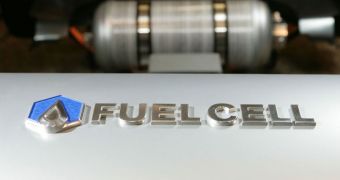Scientists say hydrogen is the way to go in the future. There's plenty of hydrogen all around us, it is completely environmentally friendly and can provide the energy required to power our cars. No sweat, we'll be having fuel cell cars in no time! However, while harnessing its power would be no problem, storing it could prove a difficult one. Compressing hydrogen gas is not as easy as it sounds, neither is keeping it under tremendous pressure. One small puncture in the hydrogen fuel tank will surely guarantee that you'll reach heaven in time to view the explosion from up there. And something tells me you would not be the only one, they don't call it the atomic bomb for nothing!
There is one solution though, in combining hydrogen gas with other chemicals in order to form a solid substance which can be broken up to slowly release the volume of hydrogen. By implying the use of such techniques, hydrogen gas would be stored in small volumes at high density, without the disadvantage of the high pressure to keep the gas compressed. But then, there is another problem. How does one release hydrogen in slow rates and what guarantees that the process won't go out of hand, determining an explosion?
It is not certain for now, but scientists are making progress. For example, University of Utah chemist Zhigang Fak says he has found one of the methods to control the slow release of hydrogen gas. A reaction between hydrogen and lithium, resulting in the creation of lithium hydride and lithium hydroxine, would be relatively easy to control and release afterwards by using various catalysts, such as platinum.
Alternative preservatives do exist, such as wooden housings and fencing materials, but they contain copper-based substances to regulate the fungi growth, substances which are not very friendly with the environment, frequently resulting in water poisoning. In consequence, wooden housing preservatives containing copper-based materials have been banned from use.
A new solution proposed by the Department of Forest Products at Mississippi State University, Starkville, suggests the use of natural resins as alternative regulating substance for the fungi. Just by spraying the resin on the surface of the wood would in effect protect it from the devastating action of fungi and other biological factors degrading it.
Secondly, hydrogen fuel cells also get competition from Methanol fuel cells, which convert the fuel and oxidant mix directly into electric energy without combustion.
However, until the apparition of hydrogen fuel cell cars scientists still have some unsolved business with the fuel cell design. It is clear that major improvements still need to be done before fuel cells reach a reasonable fuel-electric energy efficiency. Silicon-based nanowires and silver nanowires coated with platinum nanotubes are today the top contenders for fuel cell electrodes; however, the catalytic reactions still remain elusive.
Chemical engineer Yushan Yah, from the University of California, argues that by adding platinum salts to the silver nanowires he would eventually succeed in creating platinum shells, once the wires are being dissolved, to provide with increased conversion efficiency and reliability.

 14 DAY TRIAL //
14 DAY TRIAL //